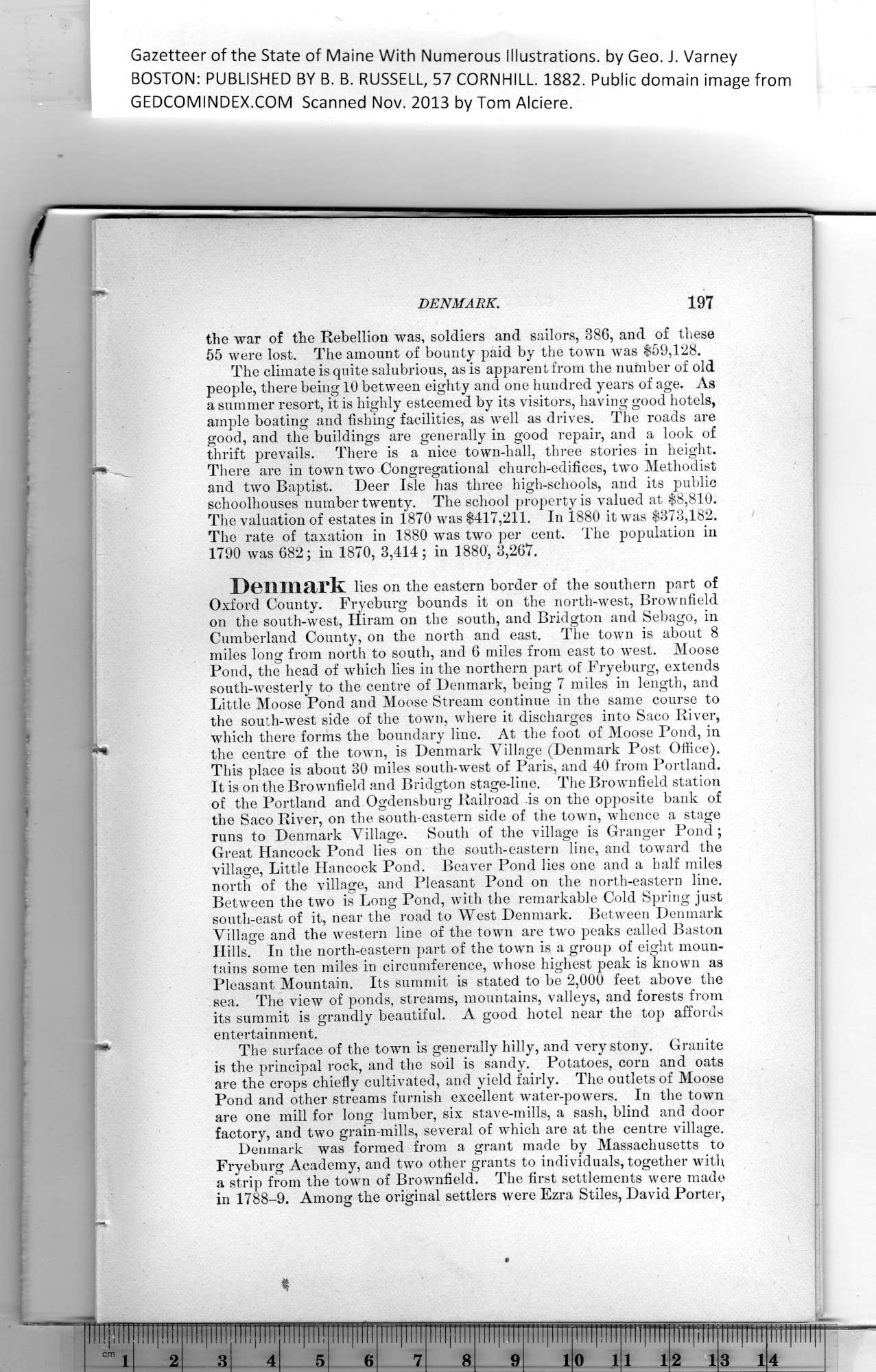|
Gazetteer of the State of Maine With Numerous Illustrations, by Geo. J. Varney
BOSTON: PUBLISHED BY B. B. RUSSELL, 57 CORNHILL. 1882. Public domain image from
DENMARK. 197
the war of the Rebellion was, soldiers and sailors, 386, and of these
55 were lost. The amount of bounty paid by the town was $59,128.
The climate is quite salubrious, as is apparent from the number of old
people, there being 10 between eighty and one hundred years of age. As
a summer resort, it is highly esteemed by its visitors, having good hotels,
ample boating and fishing facilities, as well as drives. The roads are
good, and the buildings are generally in good repair, and a look of
thrift prevails. There is a nice town-hall, three stories in height.
There are in town two Congregational church-edifices, two Methodist
and two Baptist. Deer Isle has three high-schools, and its public
schoolhouses number twenty. The school property is valued at $8,810.
The valuation of estates in 1870 was $417,211. In 1880 it was $373,182.
The rate of taxation in 1880 was two per cent. The population in
1790 was 682; in 1870, 3,414; in 1880, 3,267.
Denmark lies on the eastern border of the southern part of
Oxford County. Fryeburg bounds it on the north-west, Brownfield
on the south-wrest, Hiram on the south, and Bridgton and Sebago, in
Cumberland County, on tbe north and east. The town is about 8
miles long from north to south, and 6 miles from east to west. Moose
Pond, the head of which lies in the northern part of Fryeburg, extends
south-westerly to the centre of Denmark, being 7 miles in length, and
Little Moose Pond and Moose Stream continue in the same course to
the south-west side of the town, where it discharges into Saco River,
which there forms the boundary line. At the foot of Moose Pond, in
the centre of the town, is Denmark Village (Denmark Post Office).
This place is about 30 miles south-west of Paris, and 40 from Portland.
It is on the Brownfield and Bridgton stage-line. The Brownfield station
of the Portland and Ogdensburg Railroad is on the opposite bank of
the Saco River, on the south-eastern side of the town, whence a stage
runs to Denmark Village. South of the village is Granger Pond;
Great Hancock Pond lies on the south-eastern line, and toward the
village, Little Hancock Pond. Beaver Pond lies one and a half miles
north of the village, and Pleasant Pond on the north-eastern line.
Between the two is Long Pond, with the remarkable Cold Spring just
south-east of it, near the road to West Denmark. Between Denmark
Village and the western line of the town are two peaks called Baston
Hills. In the north-eastern part of the town is a group of eight moun-
tains some ten miles in circumference, whose highest peak is known as
Pleasant Mountain. Its summit is stated to be 2,000 feet above the
sea. The view of ponds, streams, mountains, valleys, and forests from
its summit is grandly beautiful. A good hotel near the top affords
entertainment.
The surface of the town is generally hilly, and very stony. Granite
is the principal rock, and the soil is sandy. Potatoes, corn and oats
are the crops chiefly cultivated, and yield fairly. The outlets of Moose
Pond and other streams furnish excellent water-powers. In the town
are one mill for long lumber, six stave-mills, a sash, blind and door
factory, and two grain-mills, several of which are at the centre village.
Denmark was formed from a grant made by Massachusetts to
Fryeburg Academy, and two other grants to individuals, together with
a strip from the town of Brownfield. The first settlements were made
in 1788-9. Among the original settlers were Ezra Stiles, David Porter,
PREVIOUS PAGE ... NEXT PAGE
This page was written in HTML using a program written in Python 3.2
|
